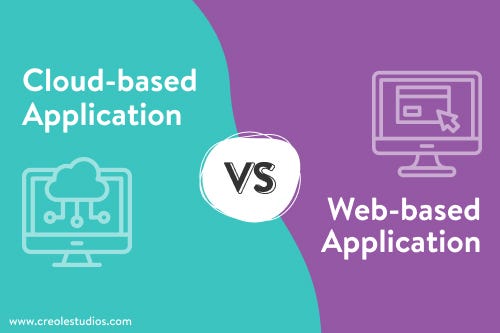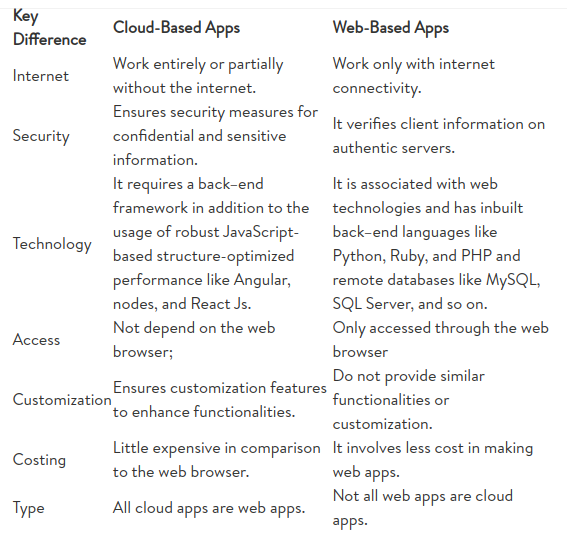Quick Summary: You’re probably not sure what cloud-based and web-based applications mean, but you know they both sound essential. One of the most important factors to consider in technology is security. You want to know that your information is safe and your data isn’t compromised. Find the difference between web apps vs. cloud apps. Read more to see what we recommend and what is safer for you.
Until the start of the current millennium, the concept of cloud-based and web-based applications were unknown. Because previously, most application developments relied on server-side solutions without using the internet, but people are still confused between the two terms. Even this situation is faced by various people, from consumers to large multinational companies. So, let’s discover the difference between cloud-based and web-based applications through this blog.

The mobile app helps the business in specific ways, like increasing customer engagement, optimizing business processes, increasing sales, and many more. It’s a fact that cloud apps and web apps are similar but not interchangeable. There is a noteworthy difference between cloud-based and web-based in terms of scalability, back–end infrastructure, and seamless integration.
What is a Cloud–Based Application?
It is an online running program with elements that store and drive online with some or other processes executed on the cloud. In a cloud-based, the entire user communicates through a web or mobile browser. The data processing is shared via a remote server base and managed with API help.
The user device is only used as an input device in the cloud app and does not interfere with other significant tasks. Besides this, cloud app development enables modern businesses and enterprises to create a product–based applications to enhance customer experience. With time there has been a growing popularity of cloud applications, and its global app market is $133. Billion in 2020, and it will reach $168.6 billion by 2025.
Types of Cloud-Based Applications
Following are some of the types of cloud-based apps:
Netflix - SaaS
The Netflix subscription service is a perfect example of a SaaS that offers a service to watch licensed videos on demand. This is how the SaaS industry got its start, even though it was referred to as a time-sharing system at the time.
AWS EC2 - IaaS
AWS Elastic Compute Service is IaaS. This is because it handles networking, storage, and virtualization. Amazon EC2 is a cloud computing service and the only IaaS offered by AWS.
AWS Elastic Beanstalk - PaaS
Using AWS Elastic Beanstalk, you can develop and scale web applications. It allows you to build application code and make it run while providing the supporting architecture and compute resources you need.
Benefits of Cloud-based Application
The cloud-based application is helpful for any business since remote servers take care of most data storage and processing issues.
Cost-saving:
The cloud services will charge only for the necessary cloud space and elements set according to the application development model. This pay–as–you–go system applies to every cloud deployment service that factors in lower cost and offers higher results.
Security:
Cloud software applications are more secure than desktop applications. If users download something, there is no chance of malware attack and putting the business at risk.
Cloud software development makes it easier to comply with government standards. Besides this, cloud applications provide helpful insight into the companies using them and how they use their resources.
Scalability:
Cloud application makes it easy to scale according to customer demand. It is because demand isn’t tied to physical resources on–site, and developers don’t require investing in the capacity they need.
What is a Web-based Application?
A web application is a computer program primarily working in online and offline modes. It is stored on the server that provides its content via a web application interface, and multiple tasks are performed via a web browser. Typical examples are online auctions, wikis, messaging apps, email, online retail sales, and many more.
Types of Web Applications
The vast IT business market for web-based software is already shifting to web applications. As we all know, many multinational companies use web apps but don’t use similar types of apps. Every business’s needs vary from one another, so the need for customized apps differs. Thus, we are here to present six different types of web applications.
Single page application:
Single-page applications are dynamic web applications that do not require browser reloads and function as a single unit of a website application. It is applied to all the business and technological strategies in the client-side browser, so the web apps perform pretty fast.
Multi-Page application:
It includes multiple pages and reloads the whole page whenever the user navigates to a different page, known as a multiple-page app. The companies like Google Docs and Trello provide multiple services and products. Thus, it allows users to connect in various ways.
Static web application:
This web app is not adaptable and is built with HTML and CSS. But changing content on static web apps is tricky because you need to download HTML code, change it and upload it to the server. The webmaster does this task.
Animated web application:
With this application’s usage, you can display your material with animation effects. These applications provide creativity and different designs unavailable in other applications.
Progressive web application:
These web technologies are created using various languages like HTML, CSS, and JavaScript. However, it is also called cross-platform web applications that use the latest browser APIs, progressive enhancement methods, and features. It offers an experience like a native mobile app.
Content management system (CMS):
In these web apps, the content is constantly updated. A CMS administrator is the person who grants permission for upgrades, modifications, and updates. WordPress is a popular CMS platform for creating commercial and personal blogs, news, etc.
Advantages of using Web-based Applications
Cross-platform compatibility:
Most web-based applications are compatible with other platforms compared to traditional installed software. However, the minimum requirement would be only web browsers which are many. So, you can still run the applications using Linux, Windows, or Mac OS.
Easy installation and maintenance:
Unlike traditional software, which is loaded on each device, web applications run on the host server. However, there is no installation and no local machines. The software will update automatically, and it reduces installation costs and upgradation. Also, it ensures that all users use a similar software version.
Customizable:
In a web application, the user interface is more accessible to customize than the desktop application. Thus, it is easy to update the look and feel of the application to customize the presentation of information to different user groups. So, the user can’t get bored using the same application and can find the perfect look for each situation.
Cloud-based vs. Web-based applications [Key differences]
With your basic understanding of web-based and cloud-based applications under your belt, let’s discuss their differences. So, let’s embark on a debate between web-based and cloud-based solutions.

Conclusion
Web apps and cloud-based apps are used in the integration to deliver a complete solution to the business. Thus, both applications come with various benefits and limitations, so selecting the correct application will depend on business needs, customer preferences, and operations.
However, to gain in-depth knowledge of how vital cloud-based apps vs. web-based apps are in daily life, connect with Creole Studios and get a customized solution for your business.
[ORIGINAL SOURCE: Cloud-based vs Web-based applications (Key Differences ]


